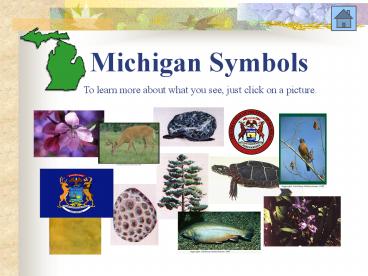Michigan Symbols - PowerPoint PPT Presentation
1 / 14
Title:
Michigan Symbols
Description:
White Tailed Deer ... Michigan county, the white-tailed deer is an important natural and economic resource. Every year, deer hunting adds more than $400 ... – PowerPoint PPT presentation
Number of Views:663
Avg rating:3.0/5.0
Title: Michigan Symbols
1
Michigan Symbols
To learn more about what you see, just click on a
picture.
2
Apple Blossom
- The apple blossom has been the state flower since
1897. Michigan ranks second in the united states
in apple production
3
White Tailed Deer
- Found in every Michigan county, the white-tailed
deer is an important natural and economic
resource. Every year, deer hunting adds more than
400 million to the state's economy. In 1997 it
was designated the state game mammal through the
efforts of Zeeland fourth-graders to include the
white-tailed deer among Michigan's official state
symbols
4
Isle Royal Greenstone
- Primarily found in the upper peninsula,
chlorastrolite was adopted as the state gem by in
1972. Chlorastrolite (literally "green star
stone") is also known as greenstone or isle
Royale greenstone. Like the Petoskey stone,
chlorastrolite is often crafted into unique
jewelry and souvenirs. The gem ranges in color
from yellow-green to almost black and when
polished shows a turtleback pattern.
5
The Great Seal
Adopted in 1963, the seal is used on many
official state documents. The words the great
seal of the state of Michigan, A.D. MDCCCXXXV
encircle the state coat of arms. At the top of
the coat of arms, adopted in 1911, is an eagle
holding an olive branch and arrows. An elk and a
moose support a shield displaying a man standing
on a grassy peninsula. The following mottos
appear on the coat of arms E pluribus Unum (from
many, one), Tuebor (I will defend) and Si Quaeris
Peninsulam Amoenam Circumspice (if you seek a
pleasant peninsula, look about you).
6
Dwarf Lake Iris
- In 1998 the dwarf lake iris was designated as
Michigan's official state wildflower. Now
endangered, the vibrant purple flower was first
discovered in Michigan in 1810. Native to the
state, it grows predominantly along the northern
shorelines of lakes Michigan and Huron.
7
Michigan Flag
- The present flagMichigan's third since becoming
a state in 1837was adopted by public act 209 of
1911. The state's first flag featured on one side
a portrait of Michigan's first governor, Stevens
T. Mason. On the other side was the state coat of
arms and a soldier and a lady. In 1865, the
state flag changed to display the Michigan coat
of arms on one side and the united states coat of
arms on the other side. Today's Michigan flag is
a field of blue with the state coat of arms at
its center.
8
Robin
- The robin became the state bird in 1931. They are
one of the earliest birds to migrate in the
spring. You can recognize a robin by its bright
red chest and gray/brown body.
Click on the picture to see the lyrics for When
the Red Red Robin Comes Bob-Bob-Bobbin Along
and here the music.
9
Petoskey Stone
- Adopted as the state stone in 1965, Petoskey
stones are often made into jewelry and curios
The stones are also a favorite of collectors of
all ages. The Petoskey stone is actually a
fossilized coral from a coral reef that existed
in the northern lower peninsula during the
Devonian era, 350 million years ago.
10
White Pine
- The white pine became the state tree in 1955.
From 1869 to the early 1900s, Michigan led the
nation in lumber production. During those years a
transportation network and communities grew
across the state to accommodate the lumber boom.
11
Brook Trout
- More than twenty years after designating the
trout as Michigan's state fish in 1965, the
Michigan legislature specified one type of
troutbrook . native to Michigan and found
throughout the state, the brook trout was adopted
as the state fish in 1988.
12
Painted Turtle
- Perhaps the most common of turtles, the painted
turtle owes its place among Michigan's state
symbols to a group of Niles fifth-graders. After
discovering that no reptile represented the
state, the children approached their state
representative and followed the legislative
process to have it names as the state reptile in
1995.
13
Kalkaska Sand
- Designated in 1990, Kalkaska sand has
distinctive layers ranging in color from black to
yellowish brown. Soil is a vital natural
resource. First identified as a soil type in
1927, Kalkaska sand is one of more than 500 soils
found in the state. Unique to Michigan, Kalkaska
sand covers nearly a million acres in 29 upper
and lower peninsula counties.
14
Red, Red Robin
- When the red, red robin comes bob, bob bobbin'
along, along, - There'll be no more sobbing when he starts
throbbing - His own sweet song.
- Wake up, wake up, you sleepy head,
- Get up, get up, get out of bed,
- Cheer up, cheer up the sun is red,
- Live, love, laugh and be happy.
- What if I've been blue,
- Now I'm walking through fields of flowers,
- Rain may glisten, but I still listen for hours
and hours. - I'm just a kid again, doing what I did again,
singing a song, - When the red, red robin comes bob, bob bobbin'
along.































